Vipers: only animals
2006/07/01 Gosá Oteiza, Alberto - ARANZADI Zientzi Elkarteko biologoa | Rubio Pilarte, Xabier - ARANZADI Zientzi Elkarteko biologoa Iturria: Elhuyar aldizkaria
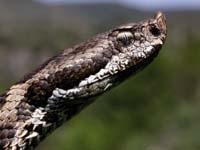
For an animal that only needs an effective attack against its prey to obtain forage, walking in scab and going far would be wasting energy. These reptiles have domestic customs and, in keeping with their slow pace of life, they are owners of small territories. In addition, they are unedible. Always depending on the weather conditions, they are able to stay awake (leaving aside the winter break or hibernation) between the months of February and March and October and November, trapped by a few animals (about three or four dams a year).
Evolution has given them the ability to take a lot of advantage of this little catch. The few ingested foods allow them to survive and grow up to 60-80 cm in length according to the species. On the contrary, the biology of the vipers limits its reproductive capacity and only every 2-3 years a new generation arises: About 10 snakes. And they do not reach maturity quickly: males arrive earlier, but females take between 4 and 6 years. Therefore, it is customary to find specimens of more than 10 years.
However, it is difficult to obtain statistics relating to the populations of vipers. As on many other occasions, in this case we do not have historical data, and the ongoing follow-up investigations are scarce. However, several cases of disappearance caused by man, such as that of the viper of Lataste, have been documented, and it is not something of the past, but a current reality that threatens the future of this species.
Each species in its place
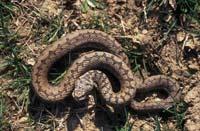
The snakes are very well distributed. Among the reptiles we will not find any other animal that shares the area with so much precision and efficiency. They do so to avoid competition from other species of nearby vipers. This behavior is also common in other species of European vipers. And it is that, by the evolutionary line followed by all, the needs of some and other species, food, shelters and, in general, customs are similar.
For example, based on a minimum energy expenditure model, they have developed a progressive hunting system that allows the dam to introduce poison through a single attack. Then, following his footprints and the heat that emerges, they find the prey and eat it. For this purpose they use a very complex organ that serves as orientation. This determinant evolutionary fact explains morphology, anatomical and physiological characteristics, and the current behavior of the viper.
In Euskal Herria there are three species of vipers: the viper aspis, the viper of Lataste (morrurluzea) and the viper cantábrica. All of them maintain the aforementioned distribution model and share the territory.
The viper Aspis is a kind of mountain that likes gravel and stones. It lives in the mountains of the Mediterranean slope, between the Navarrese Pyrenees and the Valderejo, and seeks hedges and forest edges full of bushes. It is identified with the Cantabrian viper in areas such as the foot of Gorbeia, the valleys of Aralar, Ultzama and Basaburua, Roncesvalles and Sara-Donibane Lohitzun. In all these cases the habitat is strongly divided.
The Cantabrian viper is found in cooler and humid zones, that is, in scrub and in scrub and margins of forests and grasslands, while the viper aspis is found in the harkades. On the other hand, the Cantabrian viper is common on the Atlantic slope and can reach the sea level.
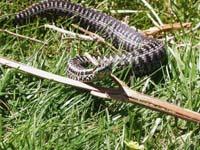
Victim of the bad reputation of the years
The viper is a calm animal and, in addition, its bite should not worry us. In this industrialized and technological Basque Country it is very difficult to die bitten by a viper. These are other times, although surprises are repeated every year.
But these bites are a sign that, on the one hand, they indicate that there are still snakes in the places that correspond to them, and on the other, they show that among human beings, as always, there is ignorance. Because the animals are quite clumsy
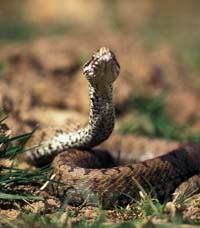
To know it, coupled with the pride and irresponsibility we have when moving into the natural environment, it can become a dangerous result.
Knowing the ways of life and customs of animals is the best way to avoid risk. In the case of vipers, it is interesting to know where they live and what their geographical distribution is. When spending the day on the mountain, we should be careful with the stone we want to pick up, or with which we want to move. People living in rural areas should know that the amount of grass that is drying up after the harvest is a preferred place for vipers. And all, whether they be baserritarras or street, we have to dress to go to the mountain, that is, boots. There are no snake teeth capable of crossing the material of the mountain boots.
However, every year there are accidents, especially towards spring. And we have said that they are accidents, because there are no snakes that have the person as prey. On the contrary, we are its predator, so if we find ourselves in front, the serpent will launch at full speed. If he bites it is a sign that we have accidentally caught him and have bothered him or hurt him. In these cases the aggression is, therefore, a measure of protection.
Keep these tips in mind...
Before a bite, the first thing to know is what you have done. Sometimes we are not sure because we do not know the animal or because it has been a sudden event. This can make it difficult for later care in the health center. And it is that, often, bites, pedrisks, bites or bites of other animals cause symptoms or infections similar to those produced by the bite of snake vipers. In any case, remember that invertebrates usually produce sting, while snakes and other vertebrates do so with bite.

If possible, it is advisable to clean the wound and, if there are no experts next door, forget the turnstiles. Never try to absorb the poison verbally or cut around the bite with a knife, since the situation can be wrong. In the first case, it is usual to have small wounds in the mouth, so you can also rejoice that person, while in the second can extend beyond taking the poison. Keep in mind that to get out of this situation, it is sufficient to monitor and control the patient's hospital, take appropriate measures and stay a few days in observation.
... and act with common sense
It is not possible to end up on the peninsula or in many places in Europe, even in Euskal Herria, not to mention a great lie intentioned. It is a lie against those who, since the 1980s, have maintained conflicting relations with the neighbors of the rural environment, that is, against the environmental departments of the administration and ecological groups.
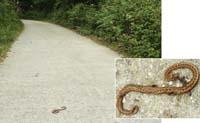
The lie is that on the mountain are released a lot of snakes carried with helicopter. This idea has neither foot nor head; moreover, knowing a little about these animals, we realize that it is crazy. It could be laughed if the subject of the vipers was not so complicated and sensitive, and if it did not produce the confrontations it has generated.
However, it must be clarified that the closed growth of the vipers is very difficult, since the biological characteristics and behavior are not adequate. It must also be made clear that no organism or government has ever begun the installation of nurseries and the capture and collection of animals on the mountain. It is evident that the lie is round. Therefore, forget the flying vipers and be clear that they are animals that move on the ground voluntarily. The more we know it, the less drawbacks we will put to vipers and, at the same time, the less surprises we will take.




